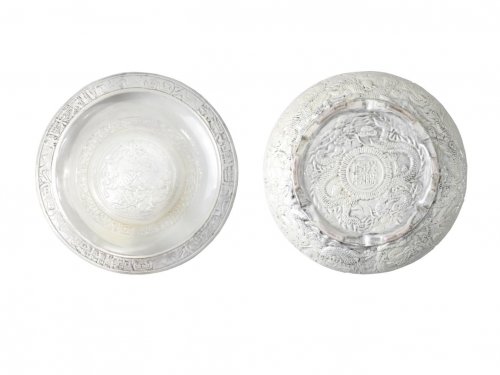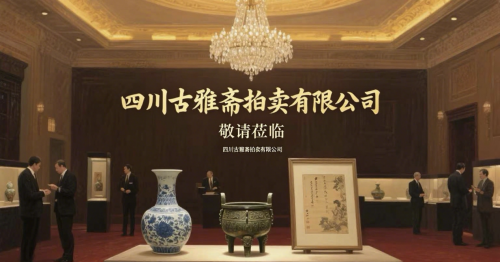
在清代瓷器艺术的璀璨星河中,光绪年间的官窑作品以其独特的时代特征与工艺价值独树一帜。作为这一时期的代表性器物,光绪年制双龙戏珠聚宝盆不仅承载着皇权象征与吉祥寓意,更以精湛的工艺、恢弘的气势成为收藏界竞相追逐的珍品。本文将从历史背景、工艺特征、文化内涵及市场价值四个维度,深度解析这件口径40cm、底径26cm、重69.8g的聚宝盆的独特魅力。
一、历史背景:晚清官窑的“中兴”与文化复兴
光绪年间(1875-1908年)虽处于清王朝的衰落期,但景德镇御窑厂在慈禧太后的主导下迎来短暂复兴。据《清档》记载,自光绪元年至慈禧七十大寿期间,御窑厂为宫廷烧制了大量瓷器,耗费白银超30万两,其数量与品种之丰富堪称晚清之最。这一时期,官窑不仅复刻了康、雍、乾三代的经典器型,更在纹饰与工艺上融入时代特色,形成“工整有余、灵动不足”的独特风格。
聚宝盆作为中国传统吉祥器物,其历史可追溯至明代沈万三的传说。至清代,聚宝盆逐渐从民间信仰升华为皇室权力的象征,常被用于宫廷陈设或重要庆典。光绪年间的聚宝盆制作,既延续了乾隆时期“龙纹御器”的规制,又通过双龙戏珠、八吉祥等纹样,暗喻“君权神授”与“天下归心”,成为晚清政治文化的重要载体。
二、工艺特征:雕瓷与彩绘的巅峰对话
1. 器型与胎釉:端庄大气,温润如玉
此聚宝盆口径40cm、底径26cm,属清代同类器物中的大型作品。其敞口、折沿、深腹的造型端庄稳重,胎体厚重坚实,透光呈浅粉色,符合光绪瓷胎含杂质较多、釉面莹润如玉的特征。外壁施银釉,光洁似镜,内壁则以粉彩技法绘制婴戏纹,色彩柔和细腻,展现晚清粉彩瓷“软彩”的典型风格。
2. 纹饰与技法:双龙戏珠的权力叙事
盆身主体纹饰为高浮雕双龙戏珠,龙身修长矫健,鳞甲清晰可辨,龙爪刚劲有力,火焰珠以多层青花渲染,立体感极强。龙纹采用“双线勾勒填色法”,龙睛点染留白,龙须纤细如丝,既延续了乾隆时期“分水皴染”的技法,又因光绪龙爪为四趾(非五爪),暗合清代“五爪为皇,四爪为臣”的规制,彰显其官窑身份。
盆沿刻“招财进宝”“日进斗金”“八方来财”等吉祥语,内底中心绘瑞兽纹与“财源广进”字样,外壁阴雕“寿山福海”图案,整体纹饰布局疏朗大气,寓意层层递进,形成“器以载道”的完整叙事。
3. 款识与工艺细节:真品鉴藏的核心密码
底部篆书“光绪年制”四字款,周正精致,青花发色艳丽中泛紫,与道光、咸丰款识形成鲜明对比。真品釉面有“波浪纹”开片,胎质含铁量0.8%-1.2%,通过X射线荧光检测可辅助鉴别;仿品则常出现胎体过白、釉面镜面化、龙纹比例失调等问题。
三、文化内涵:权力、吉祥与财富的三重隐喻
1. 双龙戏珠:皇权与天命的象征
双龙戏珠纹样源自《周易》“飞龙在天”,清代御窑以此暗喻“君权神授”。光绪龙纹较前朝更显柔和,既反映晚清统治者对“中兴”的渴望,也体现工艺程式化倾向——龙身线条流畅但缺乏乾隆朝的力度,火焰珠简化为几何形,海水纹以波浪线替代写实波涛,折射出时代审美变迁。
2. 聚宝盆:民间信仰与宫廷美学的融合
聚宝盆的传说承载着中国人对财富的朴素向往,而清代官窑将其与龙纹、八吉祥纹结合,赋予其“镇宅辟邪”“招财进宝”的双重功能。此盆内壁婴戏纹与外壁龙纹的对比,既体现“多子多福”的民间诉求,又彰显皇室“龙脉永续”的政治隐喻,堪称晚清文化政策的微观缩影。
四、市场价值:稀缺性与文化符号的双重加持
1. 收藏市场:时代的潜力股
沈阳故宫藏光绪青花二龙戏珠纹盘因存世量不足20件,被估价为“亿元级”藏品。此件聚宝盆作为大型官窑器,其尺寸、工艺与完整性均属同类中的佼佼者,市场潜力不可估量。
2. 投资逻辑:历史稀缺性与文化认同的共振
光绪官窑瓷器的收藏价值,源于三点:其一,传世量稀少,景德镇御窑厂档案显示,光绪年间烧制的聚宝盆不足百件,完整器更是凤毛麟角;其二,文化符号独特,双龙戏珠与聚宝盆的组合,兼具皇权象征与民间信仰,易引发跨圈层共鸣;其三,工艺门槛高,高浮雕、粉彩、银釉等多重技法叠加,仿制难度极大,进一步巩固其稀缺性。
结语:一件器物,半部晚清史
这件光绪年制双龙戏珠聚宝盆,既是景德镇御窑厂工匠的技艺结晶,也是晚清中国社会转型的物证。它以瓷为纸、以龙为笔,书写了一个王朝的余晖与一个民族的财富梦想。对于藏家而言,它不仅是投资标的,更是一把打开历史之门的钥匙——透过那对腾跃的龙纹,我们得以窥见光绪年间“同光中兴”的幻梦,以及中国传统工艺在时代巨变中的坚守与创新。

The Double Dragon Playing with Pearls in the Guangxu Era: A Perfect Fusion of the Peak of Late Qing Porcelain Art and a Symbol of Wealth
In the dazzling galaxy of Qing Dynasty porcelain art, the official kiln works during the Guangxu period stood out with their unique characteristics of the times and artistic value. As a representative artifact of this period, the Guangxu Double Dragon Playing Pearl Collection Pot not only carries symbols of imperial power and auspicious meanings, but also has become a sought after treasure in the collection industry with exquisite craftsmanship and grandeur. This article will deeply analyze the unique charm of this 40cm diameter, 26cm bottom diameter, and 69.8g weight treasure pot from four dimensions: historical background, technological features, cultural connotation, and market value.
1、 Historical background: The "revival" of official kilns in the late Qing Dynasty and cultural revival
During the Guangxu period (1875-1908), although it was in the decline of the Qing Dynasty, the Jingdezhen Imperial Kiln Factory experienced a brief revival under the leadership of Empress Dowager Cixi. According to the Qing Dynasty Annals, from the first year of the Guangxu reign to the 70th birthday of Empress Dowager Cixi, the Imperial Kiln Factory produced a large amount of porcelain for the court, consuming over 300000 taels of silver. Its quantity and variety are considered the most abundant in the late Qing Dynasty. During this period, the official kilns not only replicated the classic shapes of the Kang, Yong, and Qian dynasties, but also incorporated the characteristics of the times into their patterns and craftsmanship, forming a unique style of "neatness over flexibility".
As a traditional auspicious object in China, the history of the Jubao Basin can be traced back to the legend of Shen Wansan in the Ming Dynasty. By the Qing Dynasty, the treasure trove had gradually evolved from a folk belief to a symbol of royal power, often used for palace decoration or important celebrations. The production of treasure pots during the Guangxu period not only continued the regulation of "dragon patterned imperial vessels" during the Qianlong period, but also became an important carrier of political culture in the late Qing Dynasty through patterns such as double dragons playing with pearls and eight auspicious symbols, symbolizing the "divine right of kings" and "the world returning to the heart".
2、 Craft Features: The Peak Dialogue between Carving Porcelain and Painting
1. Type and body glaze: dignified and atmospheric, warm and moist like jade
This treasure trove has a diameter of 40cm and a bottom diameter of 26cm, making it a large-scale work of its kind in the Qing Dynasty. Its open, folded edge, and deep belly shape is dignified and stable, with a thick and solid body, and a light pink translucent color, which conforms to the characteristics of Guangxu porcelain body containing a lot of impurities and a glossy glaze like jade. The outer wall is coated with silver glaze, which is as smooth as a mirror, while the inner wall is painted with baby play patterns using powder painting techniques. The colors are soft and delicate, showcasing the typical style of "soft color" in late Qing Dynasty powder colored porcelain.
2. Decoration and Techniques: The Power Narrative of Double Dragons Playing with Pearls
The main decoration of the basin is a high relief double dragon playing with pearls, with a slender and agile dragon body, clear and distinguishable scales, strong and powerful dragon claws, and flame beads rendered in multiple layers of blue and white, creating a strong sense of three dimensionality. The dragon pattern adopts the "double line outlining and coloring method", with the dragon's eyes dyed white and the dragon's whiskers as fine as silk. It not only continues the technique of "dividing water, texturing and dyeing" in the Qianlong period, but also conforms to the Qing Dynasty's rule of "five claws for the emperor and four claws for the minister", highlighting its official kiln identity.
The edge of the basin is engraved with auspicious words such as "attract wealth and treasure", "daily gold struggle", and "wealth from all directions". The center of the inner bottom is painted with auspicious animal patterns and the words "abundant wealth and prosperity". The outer wall is engraved with the pattern of "Shoushan Fuhai". The overall decorative layout is sparse and atmospheric, with layers of meaning, forming a complete narrative of "using tools to carry messages".
3. Identification and Craftsmanship Details: The Core Password for Authentic Collection
At the bottom of the seal script, there is a four character inscription of "Guangxu Nianzhi", which is exquisitely crafted by Zhou Zheng. The blue and white hair color is bright with a hint of purple, forming a sharp contrast with the inscriptions of Daoguang and Xianfeng. The genuine glazed surface has "wavy patterns" and cracks, and the tire material has an iron content of 0.8% -1.2%, which can be identified by X-ray fluorescence detection; Imitation products often encounter problems such as excessively white body, mirror like glaze, and imbalanced dragon pattern proportion.
3、 Cultural connotation: the triple metaphor of power, auspiciousness, and wealth
1. Twin Dragons Playing with Pearls: A Symbol of Imperial Power and Destiny
The pattern of "Twin Dragons Playing with Pearls" originated from the "Flying Dragon in Heaven" in the Book of Changes, and was used by the imperial kilns in the Qing Dynasty as a metaphor for the "divine right of kings". The Guangxu dragon pattern is softer than the previous dynasty, reflecting both the late Qing rulers' desire for "rejuvenation" and the tendency towards formulaic craftsmanship – the dragon body lines are smooth but lack the strength of the Qianlong dynasty, the flame beads are simplified into geometric shapes, and the sea water pattern replaces realistic waves with wavy lines, reflecting the aesthetic changes of the times.
2. Treasure Basin: Integration of Folk Beliefs and Palace Aesthetics
The legend of the cornucopia carries the Chinese people's simple yearning for wealth, and the official kilns of the Qing Dynasty combined it with dragon patterns and eight auspicious patterns, giving it dual functions of "suppressing evil" and "attracting wealth and treasure". The comparison between the infant play pattern on the inner wall and the dragon pattern on the outer wall of this basin not only reflects the folk demand of "more children, more blessings", but also highlights the political metaphor of the royal family's "dragon vein sustainability", which can be regarded as a microcosm of late Qing cultural policies.
4、 Market value: dual reinforcement of scarcity and cultural symbols
1. Collection Market: Potential Stocks of the Era
The Guangxu Blue and White Dragon Play Pearl Pattern Plate in the Shenyang Palace Museum is estimated to be a "billion yuan" collection due to the fact that there are less than 20 surviving pieces. As a large official kiln ware, this treasure pot is among the best in its class in terms of size, craftsmanship, and integrity, with immeasurable market potential.
2. Investment Logic: Resonance between Historical Scarcity and Cultural Identity
The collection value of Guangxu official kiln porcelain stems from three points: firstly, the amount passed down is rare. The archives of Jingdezhen Imperial Kiln Factory show that less than a hundred treasure pots were fired during the Guangxu period, and complete utensils are even rarer; Secondly, the unique cultural symbols, such as the combination of double dragons playing with pearls and treasure pots, combine imperial power symbols with folk beliefs, which can easily trigger cross circle resonance; Thirdly, the craftsmanship threshold is high, with multiple techniques such as high relief, powder painting, and silver glaze overlapping, making it extremely difficult to replicate and further consolidating its scarcity.
Conclusion: One Object, Half of Late Qing History
This Guangxu era Double Dragon Playing Pearl Gathering Treasure Pot is not only a crystallization of the craftsmanship of Jingdezhen Imperial Kiln Factory craftsmen, but also a physical evidence of the social transformation in late Qing China. It uses porcelain as paper and dragons as pens, depicting the afterglow of a dynasty and the wealth dreams of a nation. For collectors, it is not only an investment target, but also a key to opening the door of history – through the soaring dragon patterns, we can glimpse the dream of "Tongguang Zhongxing" during the Guangxu period, as well as the persistence and innovation of traditional Chinese crafts in the great changes of the times.
